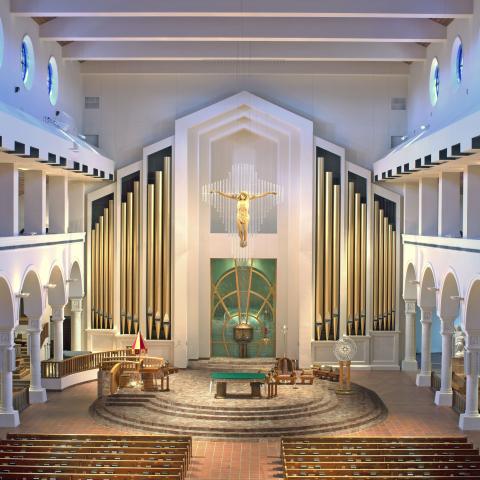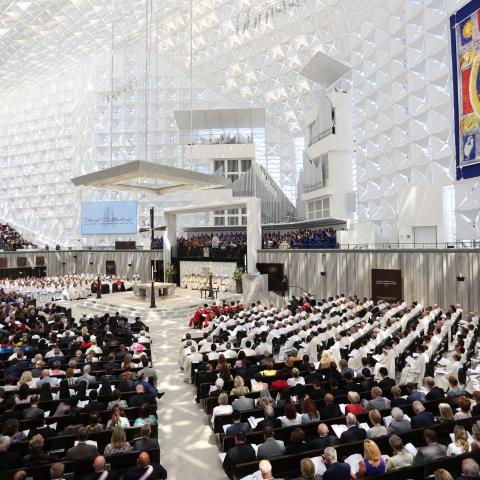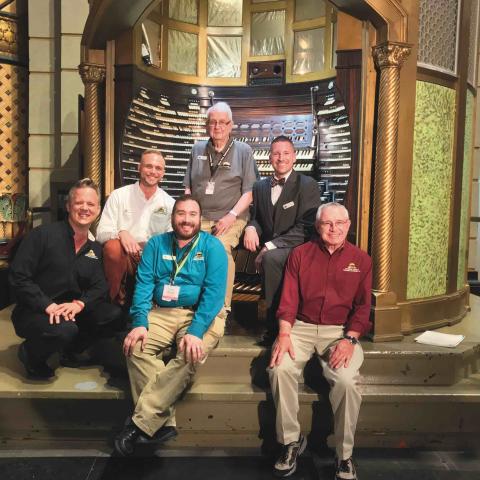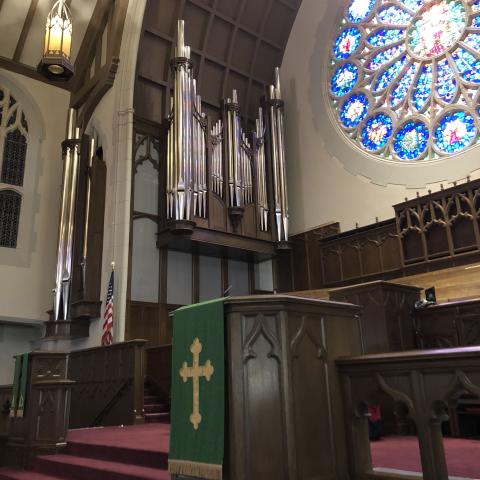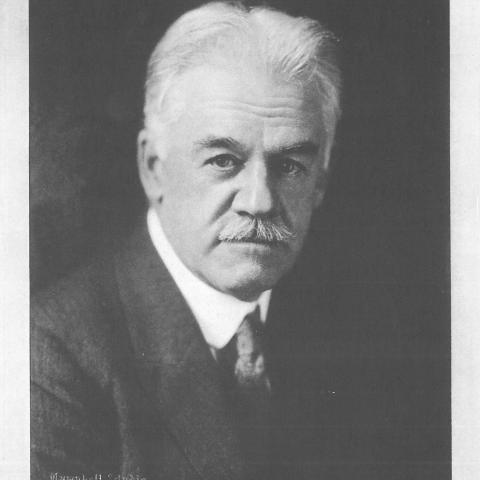The Saint Cecilia Organ, Church of the Transfiguration; Community of Jesus, Orleans, Massachusetts

If we all embrace a new vision, special guidance and support will surely come.
—Nelson Barden
On Monday, May 15, 1995, at 10:56 p.m., a fax from Nelson Barden (president, Nelson Barden & Associates, restorer-in-residence, Boston University) arrived in the music office. This was not just another fax. This document was in response to Nelson’s first visit to the Community of Jesus to meet with the superior, Mother Betty Pugsley, during which they discussed the vision, need, scope, and reason for an organ of incredible depth, proportion, beauty, and scale that would support the worship at the Community of Jesus and its world-renowned music outreach. Nelson realized instantly and exactly what she was saying, and both agreed that, “Above all other considerations, this organ must uncompromisingly spring from its spiritual and artistic vision until that vision becomes reality.”
To that end, the organ’s specification, geographic layout, and overall design were inspired and motivated by the ministry and mission of Gloriæ Dei Cantores (the resident professional choir at the Community of Jesus) as well as the community’s enthusiastic hymn singing. Gloriæ Dei Cantores performs repertoire of more than thirty nationalities, from Gregorian chant to music of the present day—a challenge for any organ to support, given the number of genres this includes!
Before meeting Nelson, we had committed to the restoration of an E. M. Skinner organ for the Church of the Transfiguration, knowing the innate beauty and flexibility of these instruments. In fact, we had already purchased, and had in storage, Skinner Organ Company Opus 762 from the Munn Avenue Presbyterian Church in East Orange, New Jersey. We soon realized, however, that this instrument would not be enough on its own and instead would need to become the basis for something far larger and with greater impact. In order to fulfill his vision and charge to unite the organ with the basilica form of the church, Nelson said, “Surround Sound:”
For this installation, I suggest rotating the traditional east-west organ placement 90 degrees to north-south and stretching the instrument completely down the nave in balconies over both side aisles. The divisions would start near the chancel (above the choir seating) with the Swell and Choir on opposite sides. These would be followed by an exposed Great and an Enclosed Great (including some Pedal) to broaden the tone and bring it down the nave . . . . Next would be matching north and south Solo divisions, followed by North and South Orchestral. These paired divisions would contain similar but distinct voices. These four matched divisions would form the “moving melody” section. . . . Near the west end would be the Bombarde/Antiphonal opposite the Echo. The shades of these divisions would not open directly toward the congregation but project the sound toward the back wall. This would modulate the heavy hitters in the Bombarde and allow the Echo to do a tonal “disappearing act.” The directional and surround effects achieved by computer control of stops and shades would lift the instrument beyond state-of-the-art into a unique realm. Moving melody could range freely over the building from left to right and front to back . . . . A single pianissimo chord from the chancel could grow into a mighty wave of sound, roll down the entire length of the nave, cascade into the Echo, and disappear.
Over the course of many years, there ensued hundreds of discussions about the numerous specifics needed to arrive at such a conclusion. (The specification alone has been through more than 150 revisions!) Only two weeks after the first fax came the next “prophetic” fax that would soon reveal the platform upon which we would collaborate for more than two and a half decades.
In addition to the primary precept of always maintaining the spiritual and artistic vision, two other significant points were developed from this second exchange:
1. Encourage apprentice-interested Community of Jesus members into the organ building field to act as good stewards in both the construction and future care of this instrument; and
2. Let the project take the time required for the organ to “teach and tell us” how it should grow and be transformed through varied experiences.
Upon mutually enthusiastic agreement, we reviewed the concepts set forth in the May 15 document in which Nelson said the organ should be:
1. World-class and unique
2. Ideally suited to your purposes
3. A tangible expression of Community of Jesus spiritual principles
4. Beautiful and musical, with instantly recognizable tone
5. Designed for posterity; built to last forever
6. Able to perform both nineteenth-century music authentically and eighteenth-century Bach convincingly
7. Capable of eliciting profound emotions
8. Designed for HDCD recordings
9. Focused on future developments, not current technology
10. A “trend setter.”
These discussion points quickly converted into:
1. Adopting the vision
2. Making the commitment to move forward
3. Incorporating the organ space into the church design
4. Refining the vision, shaping it to our precise needs
5. Defining the mechanical system of the organ
6. Developing a plan of action and a realistic budget
7. Locating a shop and storage space
8. Beginning to implement the plan of action
9. Training part-time workers and develop their expertise
10. Acquiring more component parts to restore
11. Organizing and commencing restoration work
12. Setting up a division and playing it for inspiration!
Thus, the organ restoration project began in earnest.
Fast forward to the summer of 2021, and we look back to see that Nelson’s original division layout, with some changes in nomenclature, has come true. The disposition of the divisions is as follows:
APSE
Choir Swell
North Gt (& Ped) South Gt (& Ped)
Solo (& Pedal) String (& Pedal)
Antiphonal/Processional Echo
WEST END
We were extremely fortunate to find instruments available for purchase that, together, created a “joyful musical genesis.” Below is a partial list of the Skinner organs whose components constitute this “new” instrument:
Opus 140, Trinity Episcopal Cathedral, Cleveland, Ohio
Opus 195, Williams College, Williamstown, Massachusetts
Opus 310, Plymouth Church, Shaker Heights, Ohio
Opus 473, Florida State University, Tallahassee, Florida
Opus 540, Saint Paul’s Lutheran Church, Williamsport, Pennsylvania
Opus 541, First Congregational Church, St. Petersburg, Florida
Opus 655, Saint Paul’s Episcopal Church, Rochester, New York
Opus 656, Princeton University, Princeton, New Jersey
Opus 762, Munn Avenue Presbyterian Church, East Orange, New Jersey
Opus 855, Sacred Heart Catholic Church, Pittsburgh, Pennsylvania
Opus 858, Rollins College, Winter Park, Florida
Opus 934, Saint Joseph’s College, Adrian, Michigan
Opus 991, Broadway Tabernacle, New York, New York
Opus 1242, First Baptist Church, Abilene, Texas
Nelson and the Community of Jesus have maintained an organ building apprenticeship program over these many years, having trained one of our members to journeyman status (over the course of twenty years), and four others in multi-year, work-training situations. During this time, the construction and installation truly did follow Nelson’s initial concept—division by division. This is what allowed the organ to “teach” us. Below are some other significant dates in the history of this organ:
June 2000: Dedication of the Church of the Transfiguration: North Great, Swell, and Tuba Mirabilis
June 2003: Great Artist series begins with American Guild of Organists Regions I and II convention, featuring Thomas Murray: Choir division
June 2005: Fifth anniversary of the Church of the Transfiguration: Antiphonal/Processional divisions
June 2010: Tenth anniversary of the Church of the Transfiguration: Echo division and arrival of the West End console for the concerts by Gerre and Judith Hancock and Thomas Murray
Summer 2018: 32′ Bombarde installed on South side
Summer 2019: removal of 1929 console and return of the rewired west end console serving as temporary main console
February 2020: Arrival of the final console
Our new console was designed, constructed, and installed by Richard Houghten and Joseph Zamberlan. From 2000 until 2020, we had used the original Skinner Organ Company console from Opus 762, which by 2020 the organ had long outgrown. The new console was designed to be as comfortable as a Skinner one, with everything clearly identified and within reach. Special features include shade expression thumb slides underneath the bottom three keyboards, an expression matrix so that any of the divisions can be assigned to a specific swell shoe (the entire organ is under expression), ivory keyboards that came from the Opus 762 console and are E. M. Skinner’s “tracker touch.” Some unusual couplers such as pedal to manual are included.
Perhaps the most moving realizations are the visionary outlooks of how this organ would affect people as they listened and experienced it in the setting of the Church of the Transfiguration. In concluding his initial thoughts to us in May 1995, Nelson wrote this to encourage us to take this on:
The Ultimate Goal
Every church is an expression of the builders, and so is every organ. When this instrument is finished, Community members will feel they are a part of the organ, and the organ is part of them. It will give voice to their aspirations and resonate with deep-seated meaning.
Building a magnificent instrument is hard work, sometimes tedious and always prolonged. Non-professionals may become discouraged, just as organ builders are when the job drags on. The difference is that organ builders hold a vision that gives them boundless energy and faith. They know the end result and imagine how it sounds.
Community members will understand everything when their labor comes to life and the organ starts to play. Lumber and leather, wire, and wind—if a pipe organ can sing with the angels, isn’t there hope for us all?
The list of people to thank is simply endless at this point, but here are names of those without whom this organ would not exist:
Mother Betty Pugsley
Nelson Barden
Sean O’Donnell
Joseph Sloan
Joseph Rotella
John Ananda
Jonathon Ambrosino
Duane Prill
William Czelusniak
Richard Houghten
Joseph Zamberlan
Christopher Broome
David Broome*
James Hudson Crissman
Peter Rudewicz
Thomas Murray
David Craighead*
Gerre Hancock*
*deceased
To learn more, please visit our website, www.communityofjesus.org.
—Nelson Barden and Jim Jordan
Since 1956, Nelson Barden has been recognized as one of America’s leading experts in the museum quality restoration of orchestral pipe organs—particularly the work of E. M. Skinner—and is President of Nelson Barden & Associates.
Jim Jordan is one of the organists in residence at the Church of the Transfiguration at the Community of Jesus since 1988, during which has performed as an organ accompanist for Gloriæ Dei Cantores, and a soloist throughout the United States and Eastern and Western Europe.
RELATED: View a video about the project here
Nelson Barden & Associates
Church of the Transfiguration, Orleans, Massachusetts
NORTH GREAT
1. 16′ Violone 73
2. 8′ First Diapason 61
3. 8′ Second Diapason 61
8′ Violone --
4. 8′ Harmonic Flute 61
5. 8′ Gemshorn 61
6. 8′ Gemshorn Celeste (TC) 49
7. 4′ Octave 61
8. 4′ Harmonic Flute 61
9. 2′ Fifteenth 61
10. Willis Mixture IV 244
15 19 22 26 12
12 15 19 22 24
8 12 15 19 12
1 8 12 15 13
11. 16′ Posaune 61
12. 8′ Cornopean 61
13. 4′ Clarion 61
Tremolo
North Great Sub
North Great Unison Off
North Great Super
8′ Tuba Mirabilis Choir
8′ Tuba Major Processional
8′ Trompette Militaire Processional
SOUTH GREAT
14. 16′ Gedecktpommer 68
15. 8′ Stentorphone 73
16. 8′ Principal 61
17. 8′ Bourdon 61
18. 4′ Octave 61
19. 4′ Nachthorn 61
20. 2-2⁄3′ Twelfth 61
21. 2′ Fifteenth 61
22. Fourniture III–V 245
15 19 22 12
12 15 19 22 12
8 12 15 19 12
1 8 12 15 12
1 5 8 12 15 13
23. Scharff III–IV 220
15 19 22 18
12 15 19 6
12 15 17 19 18
8 12 15 17 6
8 10 12 15 13
24. 16′ Willis Trombone 56
25. 8′ Willis Trumpet 61
26. 8′ Hautbois 68
27. 4′ Clairon 68
Tremolo
South Great Unison Off
East Chimes
SWELL
28. 16′ Bourdon 73
29. 8′ Diapason 73
30. 8′ Salicional 73
31. 8′ Voix Celeste 73
8′ Bourdon (ext 16′ Bourdon) --
32. 8′ Rohrflöte 61
33. 8′ Flauto Dolce 73
34. 8′ Flute Celeste (TC) 61
35. 4′ Octave 73
36. 4′ Triangle Flute 73
37. 2′ Flautino 61
38. Willis Mixture IV 244
15 19 22 26 12
8 12 15 19 36
1 8 12 15 13
39. 16′ Waldhorn 73
40. 8′ Trumpet 73
41. 8′ Oboe d’Amour 73
42. 8′ Vox Humana 73
43. 4′ Clarion 61
Tremolo
Swell Sub
Swell Unison Off
Swell Super
8′ Tuba Mirabilis Choir
8′ Tuba Major Processional
8′ Trompette Militaire Processional
Orchestral Bells
Orchestral Harp
ANTIPHONAL
44. 16′ Lieblich Bourdon 61
45. 8′ Diapason 73
46. 8′ Gross Flute 73
47. 8′ Clarabella 73
48. 8′ Erzähler Celeste II (celeste TC) 134
49. 4′ Principal 61
50. 4′ Harmonic Flute 61
51. Mixture IV 244
12 15 19 22 18
8 12 15 19 12
1 8 12 15 31
Tremolo
Antiphonal Sub
Antiphonal Unison Off
Antiphonal Super
CHOIR
52. 16′ Erzähler 85
53. 8′ Diapason 73
54. 8′ Cello 73
55. 8′ Cello Celeste 73
56. 8′ Viola 73
57. 8′ Viola Celeste 73
58. 8′ Concert Flute 73
59. 8′ Lieblich Gedeckt 73
8′ Erzähler --
60. 8′ Erzähler Celeste 73
61. 8′ Aeoline Celeste II (celeste TC) 110
62. 4′ Principal 73
63. 4′ Flute 61
64. 2-2⁄3′ Nazard 61
65. 2′ Piccolo 61
66. 1-3⁄5′ Tierce 61
67. 1′ Sifflöte (to f54) 54
68. Low Mixture III–IV 207
15 19 22 12
12 15 19 12
8 12 15 13
1 8 12 15 24
69. High Mixture III 183
22 26 29 18
19 22 26 12
15 19 22 12
12 15 19 6
8 12 15 13
70. 16′ Heckelphone 73
8′ Heckelphone --
71. 8′ Flügel Horn 73
72. 8′ English Horn 73
73. 8′ Clarinet 73
Tremolo
74. 8′ Tuba Mirabilis 67
Choir Sub
Choir Unison Off
Choir Super
PROCESSIONAL
75. 8′ Principal Diapason 73
76. 8′ Gamba Celeste II 146
77. 8′ Orchestral Flute 73
78. 8′ Chorus Trumpet 73
Tremolo
79. 8′ Tuba Major 73
80. 8′ Trompette Militaire 73
Processional Sub
Processional Unison Off
Processional Super
STRING
16′ Double Violin (Kimball, ext) --
16′ Contra Viol (Haskell, ext. Ætheria)
81. 16′ Bourdon 73
82. 8′ Diapason 61
83. 8′ Violin 85
84. 8′ Violin Celeste 73
85. 8′ Cello 73
86. 8′ Cello Celeste 73
87. 8′ Flared Gamba 73
88. 8′ Flared Gamba Celeste 73
89. 8′ Gross Gamba 73
90. 8′ Gross Gamba Celeste 73
91. 8′ Cellos II (flat-front) 134
92. 8′ Salicional 73
93. 8′ Voix Celeste 73
94. 8′ Viole Ætheria 97
95. 8′ Viole Ætheria Celeste (TC) 61
96. 8′ Voix Celeste II (celeste TC) 110
97. 8′ Chimney Flute 73
98. 8′ Dulciana 73
99. 8′ Unda Maris (TC) 61
100. 8′ Quintadena 73
101. 8′ Quintadena Celeste (TC) 61
102. 8′ Flute Celeste II (celeste TC) 110
4′ Violin Celeste II --
4′ Violina Ætheria --
4′ Voix Celeste II --
103. 4′ Triangle Flute 61
104. 2-2⁄3′ String Nazard 61
2′ Violette
105. 1-3⁄5′ String Tierce (to c49) 49
106. 8′ Cornopean 61
107. 8′ French Horn 61
108. 8′ English Horn (free reed) 61
109. 8′ Oboe (labial) 61
110. 8′ Vox Humana (TC) 49
Tremolo
String Sub
String Super
String Unison Off
SOLO
111. 8′ Horn Diapason 73
112. 8′ Flauto Mirabilis 73
113. 8′ Saxophone (wood) 73
114. 8′ Viola 73
115. 8′ Viola Celeste 73
116. 8′ Dulcet II 146
117. 8′ Silver Flute 73
118. 4′ Concert Flute 61
119. 4′ Viole Celeste II 122
4′ Silver Flute --
120. 8′ English Horn 73
121. 8′ Labial Clarinet 61
122. 8′ Orchestral Oboe 73
Tremolo
8′ Tuba Mirabilis Choir
8′ Tuba Major Processional
8′ Trompette Militaire Processional
Tremolo
Solo Sub
Solo Unison Off
Solo Super
Orchestral Harp
Harp
Orchestral Bells
East Chimes—West Chimes
ECHO
123. 8′ Echo Principal 61
124. 8′ Gamba 66
125. 8′ Dulcet Celeste II 146
126. 8′ Philomela 73
127. 8′ Fern Flute 73
128. 8′ Wood Celeste (TC) 49
129. 8′ Muted Viole 73
130. 8′ Muted Viole Celeste 73
131. 8′ Spitzflute Celeste II (celeste TC) 134
132. 8′ Double-Enclosed Aeoline 61
133. 4′ Fugara 61
134. 4′ Harmonic Flute 61
135. 2′ Piccolo 61
16′ Clarinet (Bassoon bass) 12
136. 8′ Clarinet (free-reed) 73
Tremolo
137. 16′ Bass Vox 73
138. 8′ Baritone Vox 73
139. 8′ Tenor Vox 73
140. 8′ Alto Vox 73
141. 8-4′ Soprano Vox I-II 112
142. 8′ Vox Humana (doubly-enclosed) 61
143. Aeolian Mixture IV–V 275
8 12 15 17 18
1 8 12 15 17 31
1 8 12 15 12
Vox Chorus Tremolo
PEDAL
64′ Gravissima --
32′ Open Wood (ext Major Bass) 12
32′ Erzähler (ext Choir) 12
144. 16′ Open Wood 56
145. 16′ Major Bass (wood, Haskell bass) 44
146. 16′ Open Diapason (metal) 32
16′ Double Violin String
16′ Violone North Great
16′ Contra Viol String
16′ Erzähler Choir
16′ Bourdon Swell
16′ Echo Bourdon String
16′ Lieblich Bourdon Processional
. 16′ Gedecktpommer South Great
147. 16′ Quintadena (in Echo) 32
8′ Open Wood --
148. 8′ Principal 44
8′ Major Bass --
8′ Violone North Great
8′ Viol Ætheria String
8′ Concert Flute Choir
8′ Erzähler Choir
8′ Gedeckt Swell
8′ Still Gedeckt String
8′ Lieblich Gedeckt Processional
4′ Octave --
4′ Concert Flute Choir
4′ Erzähler Choir
4′ Gedeckt Swell
32′ Bombarde --
32′ Waldhorn (TC) Swell
149. 16′ Bombarde 56
16′ Posaune North Great
16′ Willis Trombone South Great
16′ Waldhorn Swell
16′ Heckelphone Choir
16′ Clarinet Echo
8′ Bombarde --
8′ Heckelphone Choir
8′ English Horn Choir
4′ Heckelphone Choir
8′ Tuba Mirabilis Choir
8′ Tuba Major Processional
8′ Trompette Militaire Processional
COUPLERS
N. Great to Pedal
N. Great to Pedal 4
S. Great to Pedal
S. Great to Pedal 4
Swell to Pedal
Swell to Pedal 4
Choir to Pedal
Choir to Pedal 4
Solo to Pedal
Solo to Pedal 4
Swell to Great 16
Swell to Great
Swell to Great 4
Choir to Great 16
Choir to Great
Choir to Great 4
Solo to Great 16
Solo to Great
Solo to Great 4
Solo to Swell
Choir to Swell
Great to Solo
Swell to Solo
Swell to Choir 16
Swell to Choir
Swell to Choir 4
Solo to Choir 16
Solo to Choir
Solo to Choir 4
String on Great
Echo on Great
Antiph. on Great
Proc. on Great
String on Swell
Echo on Swell
Antiph. on Swell
Proc. on Swell
String on Choir
Echo on Choir
Antiph. on Choir
Proc. on Choir
String on Solo
Echo on Solo
Antiph. on Solo
Proc. on Solo
BALANCED PEDALS
I—II—III—IV—V/Crescendo
EXPRESSION THUMB SLIDES
Swell—Great—Choir
EXPRESSION MATRIX
Assigns any of the following onto any or all of the balanced pedals and thumb slides. When an enclosure or control is assigned to more than one pedal or slide, the pedal or slide open furthest takes precedent.
North Great
South Great
Swell
Choir
Solo
Echo (west end only)
Interior Echo (speaking into String enclosure)
String
Pedal
Antiphonal
Processional
Tremolo Speed
Tremolo Depth
All Swells
The Matrix has its own divisionals
Standard–1–2–3–4–5–6–7
COMBINATIONS
Generals 1–25 / 1–10 Thumb/Toe
Great 1–10 Thumb
Swell 1–10 Thumb
Choir 1–10 Thumb
Solo 1–8 Thumb
Pedal 1–10 Toe
Great to Pedal Thumb/Toe
Swell to Pedal Thumb/Toe
Choir to Pedal Thumb
Solo to Pedal Thumb
All Divisionals Next – All Generals Next
Next and Previous (multiple)
Library – Scope – Set – Cancel
Solid State Organ Systems Organist Palette
149 independent stops
185 ranks
11,964 pipes

